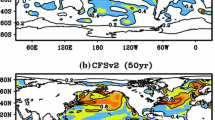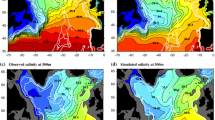Abstract
A 10-year simulation with a coupled ocean-atmosphere general circulation model (CGCM) is presented. The model consists of the climate version of the Météo-France global forecasting model, ARPEGE, coupled to the LODYC oceanic model, OPA, by the CERFACS coupling package OASIS. The oceanic component is dynamically active over the tropical Pacific, while climatological time-dependent sea surface temperatures (SSTs) are prescribed outside of the Pacific domain. The coupled model shows little drift and exhibits a very regular seasonal cycle. The climatological mean state and seasonal cycle are well simulated by the coupled model. In particular, the oceanic surface current pattern is accurately depicted and the location and intensity of the Equatorial Undercurrent (EUC) are in good agreement with available data. The seasonal cycle of equatorial SSTs captures quite realistically the annual harmonic. Some deficiencies remain including a weak zonal equatorial SST gradient, underestimated wind stress over the Pacific equatorial band and an additional inter-tropical convergence zone (ITCZ) south of the equator in northern winter and spring. Weak interannual variability is present in the equatorial SST signal with a maximum amplitude of 0.5°C.
Similar content being viewed by others
References
Barnett TP, Graham NE, Cane MA, Zebiak SE, Dolan SC, O'Brien JJ, Legeler DM (1988) On the prediction of the El Nino of 1986–1987. Science 241:192–196
Belamari S, Terray L (1993) Simulation of the 1986–1987 El Niño and 1988 La Niña events with a high resolution tropical Pacific ocean general circulation model. CERFACS Techn Rep, CERFACS STR/CMGC/93-30 (to be submitted to J Phys Oceanogr)
Blanke B, Delecluse P (1993) Low frequency variability of the tropical Atlantic ocean simulated by a general circulation model with mixed layer physics. J Phys Oceanogr 23:1363–1388
Bougeault P (1985) A simple parameterization of the large-scale effects of deep cumulus convection. Mon Weather Rev 113:2108–2121
Busalacchi AJ, McPhaden MJ, Picaut J (1994) Variability in equatorial Pacific sea surface topography during the verification phase of the TOPEX/Poseidon mission. J Geophys Res 99(C12):24725–24738
Cane MA, Zebiak SE, Dolan SC (1986) Experimental forecasts of El Niño. Nature 321:827–832
Dandin P (1993) Variabilitésse frúency simulée dans l'océan Pacifique tropical. Thè de doctorat de luniversité Paris 6
Delecluse P, Madec G, Imbard M, Levy C (1993) OPA version 7 Ocean General Circulation Model reference manual. LODYC, Internal Rep 93/05
Déqué M, Dreveton C, Braun A, Cariolle D (1994) The climate version of Arpege/IFS: a contribution to the French community climate modelling. Clim Dyn 10:249–266
Deser C, Wallace JM (1990) Large-scale atmospheric circulation features of warm and cold episodes in the tropical Pacific. J Clim 3:1254–1281
ETOP5 (1986) 5′ × 5′ topography and elevation. Marine Geology and Geophysics Division, National Geophysical Data Center
Fujio S, Imasato N (1991) Diagnostic calculation for circulation and water mass movement in the deep Pacific. J Geophys Res 96:759–774
Geleyn JF (1987) Use of a modified Richardson number for parameterizing the effect of shallow convection. J Meteorol Soc Japan, special NWP Symp Vol: 141–149
Geleyn JF, Hollingsworth A (1979) An economical analytic method for the computation of the interaction between scattering and line absorption of radiation. Beit Phys Atmos 52:1–16
Halpern D, Weisberg R (1989) Upper ocean thermal flow fields at 0°, 28°W (Atlantic) and 0°, 140°W (Pacific) during 1983–1985. Deep-Sea Res 36:406–418
Halpern D, Knox RA, Luther DS, Philander SGH (1989) Estimates of equatorial upwelling between 140°W and 110°W during 1984. J Geophys Res 94(C6):8018–8020
Horel JD (1982) On the annual cycle of the tropical Pacific atmosphere and ocean. Mon Weather Rev 110:1863–1878
Lau NC (1985) Modelling the seasonal dependence of the atmospheric response to observed El Niños in 1962–1976. Mon Weather Rev 113:1970–1996
Levitus S (1982) Climatological atlas of the world ocean, NOAA Prof Pap
Louis JF, Tiedke M, Geleyn JF (1982) A short history of the operational PBL-parameterization at ECMWF. In: Proc ECMWF Workshop Planetary Boundary Layer Parameterization, 25–27 November 1981, pp 59–80, ECMWF, Shinfield Park, Reading, UK
Marti O, Madec G, Delecluse P (1992) Comment on “Net diffusivity in ocean general circulation models with non uniform grid“. J Geophys Res 97(C8):12763–12766
McPhaden MJ, McCarthy M (1992) Mean seasonal cycles and interannual variation at 0°, 110°W and 0°, 140°W during 1980–1991. Tech Rep, ERL-PMEL, NOAA 95
Mechoso CR, Kitoh A, Moorthi S, Arakawa A (1987) Numerical simulations of the atmospheric response to a sea surface temperature anomaly over the equatorial eastern Pacific ocean. Mon Weather Rev 115:2938–2956
Mechoso CR, Robertson AW, Barth N, Davey MK, Delecluse P, Gent PR, Ineson S, Kirtman B, Latif M, Le Trent H, Nagai T, Neelin JD, Philander SGH, Polcher J, Schopf PS, Stockdale T, Suarez MJ, Terray L, Thual O, Tribbia J (1995) The seasonal cycle over the tropical Pacific in general circulation models. Mon Weather Rev (in press)
Miller MJ, Beljaars ACM, Palmer TN (1991) The sensitivity of the ECMWF model to the parameterization of evaporation from the tropical oceans. J Clim 5:418–434
Millero FJ, Poisson A (1981) International one-atmosphere equation of state of sea-water. Deep-Sea Res 28A:625–629
Mitchell TP, Wallace JM (1992) The annual cycle equatorial convection and sea surface temperature. J Clim 5:1140–1156
Neelin JD, Latif M, Allaart MAF, Cane MA, Cubasch U, Gates WL, Gent PR, Ghil M, Gordon C, Lau NC, Mechoso CR, Meehl GA, Oberhuber JM, Philander SGH, Schopf PS, Sperber KR, Sterl A, Tokioka T, Tribbia J, Zebiak SE (1992) Tropical air-sea interaction in general circulation models. Clim Dyn 7:73–104
Oberhuber JM (1988) An atlas based on the CORDS data set: the budget of heat, buoyancy and turbulent kinetic energy at the surface of the global ocean. Max-Planck-Institut für Meteorologie Rep 15
Palmer TN, Mansfield DA (1986) A study of wintertime circulation anomalies during past El Niños events using a high-resolution general circulation model. Part I: influence of model climatology. Q J R Meteorol Soc 112:613–638
Philander SGH, Seigel AD (1985) Simulation of the El Niño of 1982–1983. In: Nihoul JCJ (ed) Coupled ocean-atmosphere models. Amsterdam, Elsevier Oceanography Ser 40:517–541
Philander SGH, Pacanowski RC, Lau NC, Nath MJ (1991) A simulation of the Southern Oscillation with a global atmospheric GCM coupled to a high-resolution, tropical Pacific ocean GCM. J Clim 5:308–329
Reverdin G, Delecluse P, Levy C, Andrich P, Morliere A, Verstraete JM (1991) The near surface tropical Atlantic in 1982–84. Results from a numerical simulation and a data analysis. Prog Oceanogr 27:273–340
Reynolds RW (1988) A real-time global sea surface temperature analysis. J Clim 1:75–86
Ritter B, Geleyn JF (1992) A comprehensive radiation scheme for numerical weather prediction models with potential applications in climate simulations. Mon Weather Rev 120:303–325
Sarmiento JL, Bryan K (1982) An ocean transport model for the north Atlantic. J Geophys Res 87:394–408
Stephenson D, Royer JF (1994) GCM simulations of the Southern Oscillation for 1979–1988. Clim Dyn (in press)
Terray L (1994) The OASIS Coupler User Guide Version 1.0, CERFACS Technical Report, CERFACS TR/CMGC/94-33
Trenberth KE (1984) Signal versus noise in the Southern Oscillation. Mon Weather Rev 112:326–332
Unesco (1983) Algorithms for computation of fundamental property of sea water, Unesco Techn Pap Marine Science, 44
Waliser DE, Gautier C (1993) A satellite-derived climatology of the ITCZ. J Clim 6:2162–2174
Wessel P, Smith WHF (1991) Free software helps map and display data. EOS Trans Am Geophys Union 72:441, 445–446
Wright PB (1988) An atlas based on the COADS data set: field of mean wind, cloudiness and humidity at the surface of the global ocean. Max-Planck-Institut ftir Meteorologic Rep 14
Wyrtki K (1985) Water displacements in the Pacific and the genesis of El Niño cycles. J Geophys Res 90(C4):7129–7132
Wyrtki K, Kilonsky B (1984) Mean water and current structure during the Hawaii-to-Tahiti shuttle experiment. J Phys Oceanogr 14:242–254
Author information
Authors and Affiliations
Rights and permissions
About this article
Cite this article
Terray, L., Thual, O., Belamari, S. et al. Climatology and interannual variability simulated by the ARPEGE-OPA coupled model. Climate Dynamics 11, 487–505 (1995). https://doi.org/10.1007/BF00207197
Received:
Accepted:
Issue Date:
DOI: https://doi.org/10.1007/BF00207197




